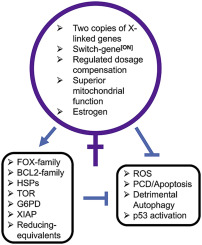Redox Biology ( IF 10.7 ) Pub Date : 2020-03-09 , DOI: 10.1016/j.redox.2020.101488 John Tower 1 , Laura C D Pomatto 2 , Kelvin J A Davies 3

|
Sex differences in diseases involving oxidative and proteolytic stress are common, including greater ischemic heart disease, Parkinson disease and stroke in men, and greater Alzheimer disease in women. Sex differences are also observed in stress response of cells and tissues, where female cells are generally more resistant to heat and oxidative stress-induced cell death. Studies implicate beneficial effects of estrogen, as well as cell-autonomous effects including superior mitochondrial function and increased expression of stress response genes in female cells relative to male cells. The p53 and forkhead box (FOX)-family genes, heat shock proteins (HSPs), and the apoptosis and autophagy pathways appear particularly important in mediating sex differences in stress response.
中文翻译:

对氧化和蛋白水解应激反应的性别差异。
涉及氧化和蛋白水解应激的疾病的性别差异很常见,包括男性更严重的缺血性心脏病、帕金森病和中风,以及女性更严重的阿尔茨海默病。在细胞和组织的应激反应中也观察到性别差异,其中雌性细胞通常对热和氧化应激诱导的细胞死亡具有更强的抵抗力。研究表明雌激素的有益作用以及细胞自主效应,包括相对于雄性细胞,雌性细胞中线粒体功能更佳和应激反应基因表达增加。 p53和叉头框 (FOX) -家族基因、热休克蛋白 (HSP) 以及细胞凋亡和自噬途径在调节应激反应的性别差异方面显得特别重要。











































 京公网安备 11010802027423号
京公网安备 11010802027423号